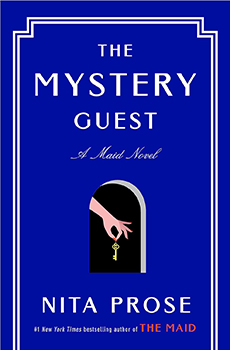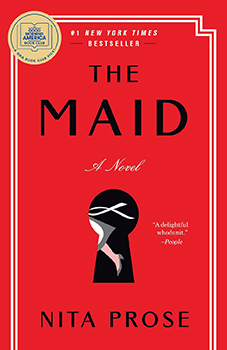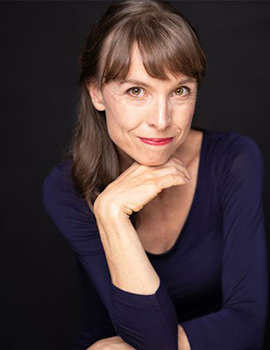

Features Nita Prose
Molly Gray Has it Maid…Or Does She?
The Big Thrill Interviews Nita Prose
 When an author writes an amazing debut novel, we, as readers, wait with hopeful impatience for their second novel to appear on bookstore shelves. Will it arrive soon? Will we like the characters we will be introduced to? How is our hero going to untangle the mystery?
When an author writes an amazing debut novel, we, as readers, wait with hopeful impatience for their second novel to appear on bookstore shelves. Will it arrive soon? Will we like the characters we will be introduced to? How is our hero going to untangle the mystery?
Will it be as good as their first?
In the case of Nita Prose’s new novel, THE MYSTERY GUEST—the follow-up to her hit debut, The Maid—the answers are yes, yes, spoilers, and YES.
THE MYSTERY GUEST takes place four years after the events in The Maid. We see Molly firmly established in her role as Head Maid, with a level of confidence she hadn’t seemed capable of in The Maid.
It’s this new Molly who must take the reins of the investigation when her protégé maid-in-training, Lily, is implicated in the death of famously reclusive author J.D. Grimthorpe, who collapses in the tearoom of her hotel before he can make a highly anticipated announcement.
Even though she’s faced with her old nemesis, Detective Stark, Molly is determined to root out the culprit and save Lily from being arrested in this charming, character-driven novel.
The Big Thrill was pleased to sit down with Nita Prose to discuss how she writes Molly’s stories and uses fables and fairy tales as inspiration for mysteries.
I’ve heard you wrote The Maid in secret. But given your success, everyone knew you were writing THE MYSTERY GUEST. How did this change your writing experience?
I did write The Maid in utter secrecy. I didn’t want thoughts about anything else except the story and whether I could get through that maze of the narrative to the end of the story. This time, it’s like, Wow! There’s a lot of pressure! But I had to just sort of ignore all that noise and just focus on story, focus on Molly, and finding a new terrain.
With The Maid, I Frankensteined together the mystery genre and feel-good fiction. I had a murder mystery on the one hand, and on the other, a journey of spirit and hope. Those two things don’t readily go together.
The second time [with THE MYSTERY GUEST], it was all about genre again. Once I figured out that it was going to be a mystery on the front end and on the back end a sort of fairy tale for adults, it opened up my imagination where I could pursue story and ignore everything else.
You start THE MYSTERY GUEST with a fable about the maid, the rat, and the spoon. Where did this fable come from, and why use it as the theme for THE MYSTERY GUEST?
It came to me while I was on tour for The Maid. I was visiting a museum outside of Brighton and came across the most unusual display. It included the mummified body of a rat and a single silver spoon in a display case. And I thought, “This is so weird. What is this doing here?” And then I read the description.
It turns out, in the 17th century, there was a maid servant who used to work in the castle, and she was unceremoniously dismissed after being accused of having stolen a piece of silverware. Many years later, they were reconstructing the castle. They opened up the walls, and inside one of those walls, they found a nest with the mummified body of a rat and a single silver spoon beside it.
Many of the clues in THE MYSTERY GUEST are told in flashbacks of a young Molly cleaning with Gran. Why structure the novel this way?
I wanted Molly to have to investigate her past in order to solve the present mystery. For me, that allows [her to experience] a journey of growth. In The Maid, Molly is coming into herself and finding confidence in herself, which she really lacks. At the beginning, she struggles so much, but by the end of that short week of growth, she has changed considerably.
Now, four years later, in THE MYSTERY GUEST, she has grown. She has confidence, and she’s also head maid. So, my question was, how do we grow when we know ourselves? For me, the answer to that question—in life as well as on the page—is that once we feel more settled with who we are, that’s when we can grow empathy and compassion and understanding for others. So, the second book is about Molly investigating who Gran was and the incredible unconditional sacrifices that Gran made for her to thrive and prosper.
 Cheryl, the B-level villain from The Maid, is back in THE MYSTERY GUEST. But Molly seems better equipped to deal with Cheryl’s underhandedness. Was this an intentional way of showing us Molly’s growth over the last four years?
Cheryl, the B-level villain from The Maid, is back in THE MYSTERY GUEST. But Molly seems better equipped to deal with Cheryl’s underhandedness. Was this an intentional way of showing us Molly’s growth over the last four years?
The way I create a character is to sit inside them. I know I’m in the flow when I feel I’m not myself anymore. I am Molly, and that’s where the real magic happens. Obviously, there’s a conscious force driving that, but it doesn’t feel that way when you’re in it.
What I tried to do was show how much Molly had evolved and grown as a person. While Molly is a portrait of growth, Cheryl is her polar opposite. Cheryl is precisely and exactly the same. She’s a portrait of getting stuck in the same selfish conceits. She never, ever moves—which highlights Molly’s growth. You can’t see the growth [of a character] unless it’s reflected in character dynamics.
You said Molly sort of takes over as you’re writing. Are you living the moment, or are you seeing the plot cinematically in your head?
It’s more about living the moment. You find with your conscious mind what is going to happen in that scene and then let the dialogue flow out. In a way, that can sometimes [create scenes] that are very surprising.
So, are you more of a hybrid plotter where you know what must happen in each scene and then let the scene develop organically? Or are you pretty prescriptive in your writing?
I’m a little bit of both. I need to know the big beats, the big twists and turns. I also need to know the inciting incident of a chapter in order to write it. I need a little bit of knowing and then a lot of not knowing, and then, somehow, the magic sort of makes it happen.
Who was your favorite character to write?
I had a lot of fun with Angela. She’s so sassy, and she’s one of these people who treats Molly with great respect. But on the other hand, she isn’t going to dumb anything down or be overly coddling with her. I loved those personality traits. They were really fun to play with on the page.
What are you reading?
I just read an advanced copy of A. J. Finn’s next novel, End of Story, which will come out in February. It’s such a clever, twisty mystery. It’s very dark, but it almost has a Great Gatsby feel about it too.
What’s coming up next? I know you’ve said you won’t write another Molly mystery unless you really feel like you have something to say about her. But is she speaking to you?
She is. I’m interested in figuring out if this is a trilogy. I’m exploring some new genres to pair with the mystery. So far, so good, but I’ve got a long way to go. It’s always a journey.
The Big Thrill Interviews Nita Prose
- Caroline Cleveland - May 23, 2024
- Kim Hays - May 9, 2024
- Kara Thomas - April 25, 2024

